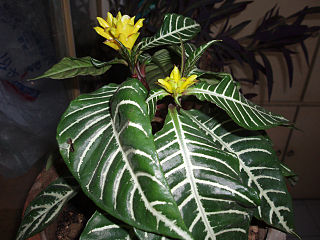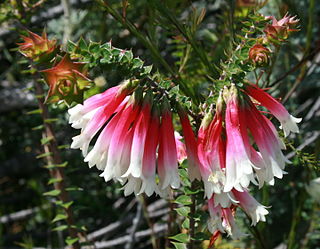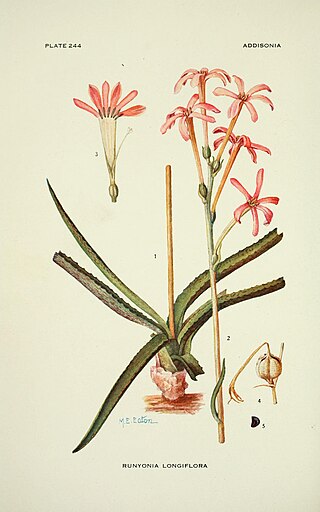
Acanthaceae is a family of dicotyledonous flowering plants containing almost 250 genera and about 2500 species. Most are tropical herbs, shrubs, or twining vines; some are epiphytes. Only a few species are distributed in temperate regions. The four main centres of distribution are Indonesia and Malaysia, Africa, Brazil, and Central America. Representatives of the family can be found in nearly every habitat, including dense or open forests, scrublands, wet fields and valleys, sea coast and marine areas, swamps, and mangrove forests.

Aphelandra is a genus of over 200 species of flowering plants in the family Acanthaceae, native to tropical regions of the Americas.

Hindsia is a genus of about 11 species of shrubs in the family Rubiaceae, native to tropical South America, mainly in Brazil. The species Hindsia longiflora and H. violacea were used to separate the genus from Rondeletia. The genus was named in honour of Richard Brinsley Hinds.

Aphelandra squarrosa is a plant species in the family Acanthaceae, which is native to Atlantic Forest vegetation of Brazil. This plant is often used as a house plant. This plant is cited in Flora Brasiliensis by Carl Friedrich Philipp von Martius.
Aphelandra rigida is a plant species in the family Acanthaceae, which is native to Atlantic Forest vegetation of Brazil.
Aphelandra albinotata is a species of plant in the family Acanthaceae. It is endemic to Ecuador. Its natural habitat is subtropical or tropical moist montane forests. It is threatened by habitat loss.
Aphelandra anderssonii is a species of plant in the family Acanthaceae. It is endemic to Ecuador. Its natural habitat is subtropical or tropical moist montane forests. It is threatened by habitat loss.
Aphelandra chrysantha is a species of plant in the family Acanthaceae. It is endemic to Ecuador. Its natural habitat is subtropical or tropical moist montane forests. It is threatened by habitat loss.
Aphelandra cinnabarina is a species of plant in the family Acanthaceae. It is endemic to Ecuador. Its natural habitat is subtropical or tropical moist montane forests. It is threatened by habitat loss.
Aphelandra guayasii is a species of plant in the family Acanthaceae. It is endemic to Ecuador. Its natural habitat is subtropical or tropical dry forests. It is threatened by habitat loss.
Aphelandra gunnari is a species of plant in the family Acanthaceae. It is endemic to Ecuador. Its natural habitat is subtropical or tropical moist montane forests. It is threatened by habitat loss.
Shorea longiflora is a species of tropical lowland rainforest tree in the family Dipterocarpaceae. It is endemic to Borneo.

Epacris longiflora, commonly known as fuchsia heath or cigarette flower, is a plant in the family Ericaceae and is endemic to eastern Australia. It is an erect or spreading shrub with egg-shaped, pointed leaves and red tube-shaped flowers which give the plant its name longiflora and are usually present throughout the year. Its native range extends from the central coast of New South Wales to southern Queensland.

Hippobroma longiflora, also called Star of Bethlehem or madamfate, is a flowering plant in the family Campanulaceae. It is the only species in the genus Hippobroma. It is endemic to the West Indies, but has become naturalized across the American tropics and Oceania.

Zebra plant is a common name for several plants and may refer to:

Agave longiflora is a species of flowering plant in the family Asparagaceae that is native to the Lower Rio Grande Valley of Texas in the United States and northern Tamaulipas in Mexico. Common names include amole de río, longflower tuberose, and Runyon's huaco. The type specimens were sent by botanist and photographer Robert Runyon (1881–1968) to the New York Botanical Garden in 1921. Consequently, the species was initially placed in a monotypic genus named in his honour, Runyonia, by Joseph Nelson Rose. The species has been placed in the genus Manfreda, now absorbed into Agave. A. longiflora is a rhizomatous perennial with 3–7 prostrate leaves in a basal rosette. It inhabits hills, terraces and slopes in the semi-arid Tamaulipan mezquital.

Aphelandra sinclairiana is a plant species commonly called coral aphelandra, orange shrimp plant, Panama queen or Sinclair's aphelandra. It is a shrub up to 3 m high, native to Central America, specifically Panama, Costa Rica, Honduras and Nicaragua. It is also cultivated in warm locations elsewhere, with pink, red, orange, or red-violet flowers and bracts.

Kalanchoe longiflora, also known as tugela cliff-kalanchoe or long-flower kalanchoe, is a species of the succulent genus Kalanchoe, in the family Crassulaceae. An obscure shrub native to South Africa, it is known for its multi-coloured foliage and yellow flowers, which bloom in autumn to winter.

Xantheranthemum, known as the golden vein plant or bronze vein plant, is a genus of flowering plants in the family Acanthaceae. It has only one currently accepted species, Xantheranthemum igneum, native to Peru. It is grown as a greenhouse or house plant. There may be some confusion caused by the names of the botanists Linden and Lindau, as some sources associate it with Aphelandra goodspeediiStandl. & F.A.Barkley, along with Chamaeranthemum igneumRegel, Eranthemum igneumLinden, Stenandrium igneum(Linden) André, Stenandrium pictumN.E.Br., and Xantheranthemum igneum(Linden) Lindau.

Rogeria longiflora, also known as the white djirrie, is a species of flowering plant in the genus Rogeria. It is native to Namibia and the northern Cape Provinces of South Africa.











